Ed Protzel's Blog, page 5
July 26, 2017
Movement to heal Civil War wounds grows; St. Louis a good case in point
Illustrating the "happy slave" myth.
Sadly, falsehoods justifying Confederacy symbols persist
Some of the myths (falsehoods) sown by Southern planters—and cultivated from the antebellum period and Reconstruction to Jim Crow—stubbornly cling to some perceptions of this pivotal upheaval in American history. These include the myth of the "happy" slave and the "benevolent" master, and the notion that the Civil War was not fought over slavery, but over states’ rights and secession. These are specious arguments.
What states wanted was the right to own slaves!
Still an emotional and controversial issue 150 years after the Civil War, the movement to remove Confederate war symbols (monuments, statues, as well as flags) from our public places, thankfully, has grown, reawakening passions and awareness of what these symbols mean and the reasons behind them, and creating front page news from South Carolina to Texas. [The New York Times: “Calls to Drop Confederate Emblems Spread Nationwide.”]
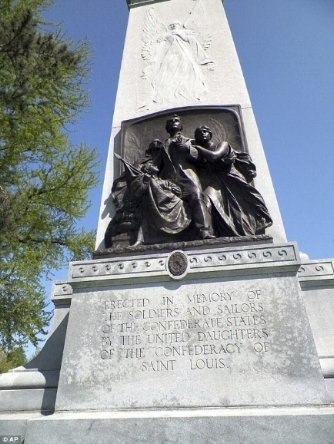
Monument moved from Forest Park in St. Louis to the Missouri Civil War Museum at Jefferson Barracks.
The St. Louis Example
Nothing could be a better barometer of times a-changin’ than here in Missouri, technically a Union state during the war, but with strong Confederate leanings. Recently in St. Louis, moving a Confederate war memorial from the city’s Forest Park to the Missouri Civil War Museum at Jefferson Barracks, an active military post during the Civil War, drew some outrage, with one letter to the St. Louis Post-Dispatch claiming: “over fifty thousand blacks fought for the Confederacy. “ [The St. Louis American, U.S. News & World Report]
This is nonsense.
The truth is, with the war lost, Gen. Robert E. Lee attempted to have the Confederacy draft slaves to fight the Union, offering them freedom in return for their service. This proposal, however, drove Confederate state legislatures into an uproar, one prominent senator declaring: “If we allow this, the war has had no point.” [Daily Beast]
Was maintaining racial superiority more important than victory?
Historically, on a rare occasion when a black Confederate company was formed and marched through a town, they were hardly met with cheers and roses. Rather, citizens actually threw rocks at them. Black Confederate soldiers never did get into battle, although there was some shooting: more a warning “don’t come this way” than an actual battle.
On the other hand, over 100,000 black soldiers and sailors, including many free blacks, did fight for the Union to free their people and to established their full manhood in the country in which they were born.
![A great book on the trials and challenges of black Union soldiers is A Grand Army of Black Men, Edited by Edwin S. Redkey. [See MELUS article.]](https://i.gr-assets.com/images/S/compressed.photo.goodreads.com/hostedimages/1501190229i/23428341.jpg)
A great book on the trials and challenges of black Union soldiers is A Grand Army of Black Men, Edited by Edwin S. Redkey. [See MELUS article.]
This “principle” is demonstrated in my upcoming Civil War novel, Honor Among Outcasts, the second in my DarkHorse Trilogy (October release). Here, the war is raging, and the DarkHorse men (former partners from Book 1, The Lies That Bind) have joined the Union army to fight Confederate guerrillas in western Missouri. Since “colored” (black) regiments were required to have a (superior) white officer, this role is played ironically by their partner, pacifist/abolitionist/foolhardy Durksen Hurst.
Note: An important element of the DarkHorse Trilogy, and my most personally compelling reason for writing it, is to debunk these hurtful falsehoods by showing the values, hopes, fears, ambitions—and flaws—we all share as human beings, and our equal right as Americans, white and black, to life, liberty and the pursuit of happiness.
Get news about the release of Honor Among Outcasts. Subscribe to Ed's email list now!July 12, 2017
Think today’s political climate is bad? Look at Civil War Missouri, where atrocities between neighbors were commonplace

The Sacking of Lawrence , May 21, 1856
Union General William Tecumseh Sherman’s famous phrase, “War is Hell,” was never more true than along the Missouri/Kansas border during the American Civil War.
Certainly, the battlefield slaughter and destruction in the eastern part of the country was brutal. But the savage guerrilla war fought in western Missouri took violence and inhumanity to a new level—even by today’s standards.
Pre-war hatred a way of lifeDuring the antebellum period, the counties bordering the Missouri River, with its rich bottom-land, were home to the majority of the state’s slave population. Hemp, a valuable commodity, was grown on plantations there and shipped east to St. Louis for transit via the Mississippi River down to New Orleans.
Decades of bloody conflict between pro- and anti-slavery factions were prevalent along the Missouri/Kansas border, which meant bad blood was already at the boiling point, waiting only for secession to touch off an explosion.
And explode it did.
Prior to the war, anti-slavery Kansas Jayhawkers and pro-slavery Missouri Rowdies raided each other back and forth across the border, spreading killing and destruction. (As part of this conflict, anti-slavery martyr, John Brown, became infamous for massacring pro-slavery civilians in Kansas.)

Battle of Pea Ridge (Missouri), March 7-8, 1862
After the Confederates were defeated at the Battle of Pea Ridge, many returned to their western Missouri homes. But Kansas Jayhawker raids stirred them to action again. In retaliation, the Confederates became guerrillas, called bushwhackers, and an escalating cycle of horrors, pitting neighbor against neighbor, was born.
How bad was the violence? As nasty as it gets.Both the Confederate guerrillas and the Union guerrilla-hunters carried out scalpings and displayed the trophies on their horses’ pommels. Yes, Americans actually did this to other Americans. Civilians were robbed and murdered; homes, farms, and towns were burned.
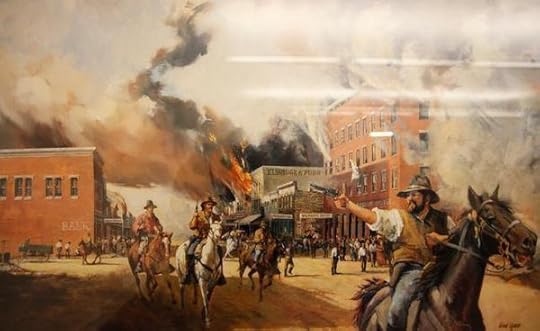
Quantrill's infamous raid on Lawrence, Kansas
On Aug. 21, 1863, Quantrill’s Confederate guerrillas raided Lawrence, Kansas, burning the town, massacring its men and boys. To clear out western Missouri, the base of most of the guerrilla activity, the Union issued General Order No. 11. Under Order No. 11, the Union army destroyed four entire Missouri border counties, burning the farms of loyal Unionists and Confederate sympathizers alike. The whole area became known as “the burnt district,” and that, in fact, is what it was.
NOTE: Researching the Civil War for my DarkHorse Trilogy brought this tragic period in our history into focus for me. Placing the characters in Honor Among Outcasts (book 2 of the trilogy) into this treacherous landscape allowed me to dramatize one of the book’s central themes—that friendship and love can overcome violence and intolerance. Naive, maybe. But who knows what people trusting each other can achieve!Watch for news about Honor Among Outcasts , scheduled for release this fall by TouchPoint Press!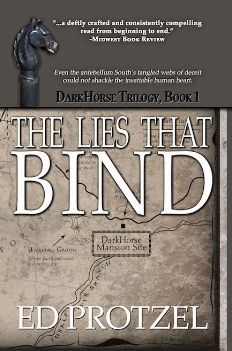
If you haven't read book 1, The Lies That Bind, order now! Subscribe to my email list if you don’t already receive my blog posts!
July 5, 2017
Woman’s Name Appears on Declaration of Independence!
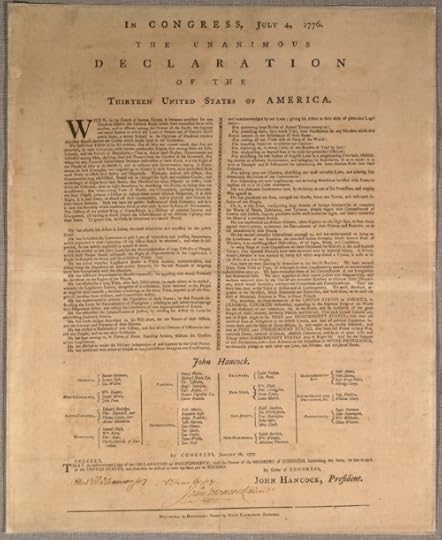
After an admittedly long hiatus to complete book 2 of my Civil War-era DarkHorse Trilogy, Honor Among Outcasts (planned for release this fall), I’m resuming my weekly blog with an emphasis on history, my special interest, which I use liberally in all my writing. So on this post-Independence Day, I thought I’d share a fascinating, little-known fact about America's history as the perfect way to re-launch my blog.
It seems that, according to a July 3 article in , a woman’s name was added to the signatures on the Declaration of Independence.
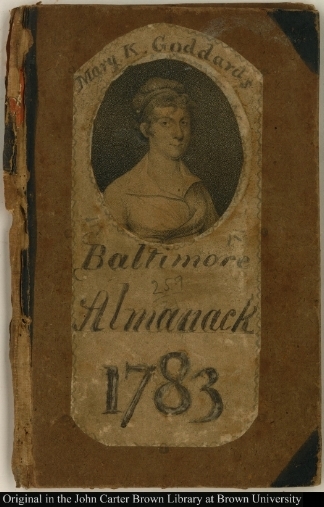
Yes. Women may not have had the vote in 1776, but that apparently didn’t stop Mary Katherine Goddard from adding her “Jane Hancock” at the bottom of printed copies of the Declaration, an act considered treason against the powerful British Empire. Not only did Goddard risk being charged with treason, according to the Post, she also received death threats. Remember, a large percentage of the original thirteen colonies’ inhabitants, perhaps about half, were Tories, meaning they remained loyal to Britain!
History, it seems, is never as clear-cut as imagined in popular mythology.
So what’s the story behind the story?Columnist Petula Dvorak writes that Goddard, a newspaper editor (and publisher), was hired by the Founding Fathers to print copies of the Declaration for distribution to the public.
As a fighter for the rights of women to pursue a career, Goddard, who must have had a great deal of chutzpah, wrote and published “scoops” on the early battles in the Revolution, including Bunker Hill. When she printed those copies of the Declaration on her presses, the gutsy Goddard added her name, along with the founders—potentially a hanging offense against the powers that be.
How’s that for speaking truth to power?
Also cited in the article was the fact that taking arms against the Empire showed that “Americans would rather die than live slaves.” Goddard must have been one tough-minded lady. Later, she ran a newspaper in Baltimore under the name M. K. Goddard, and became the first female postmaster of Baltimore.
History recognizes the “Big Names” who help bring change and new ideas to society. But sometimes the real power behind change are the great mass of people who throw real passion into fights for justice and equality. The real heroes and heroines, while often unheralded, are pervasive, and deserve our praise for their efforts.
To learn more about Mary Katherine Goddard, I recommend these two articles:
“Mary Katherine Goddard and Freedom of the Press,” by Christopher T. George
“Revolutionary Woman: Mary Katherine Goddard,” American Law Journal
Stay Connected with Ed: Like him on Facebook.Follow him on Twitter.Woman’s Signature Appears on Declaration of Independence!

After an admittedly long hiatus to complete book 2 of my Civil War-era DarkHorse Trilogy, Honor Among Outcasts (planned for release this fall), I’m resuming my weekly blog with an emphasis on history, my special interest, which I use liberally in all my writing. So on this post-Independence Day, I thought I’d share a fascinating, little-known fact about America's history as the perfect way to re-launch my blog.
It seems that, according to a July 3 article in , a woman’s name was included among the signatures on the Declaration of Independence.

Yes. Women may not have had the vote in 1776, but that apparently didn’t stop Mary Katherine Goddard from adding her “Jane Hancock” to the bottom of the Declaration, an act considered treason against the powerful British Empire. Not only did Goddard risk being charged with treason, according to the Post, she also received death threats. Remember, a large percentage of the original thirteen colonies’ inhabitants, perhaps about half, were Tories, meaning they remained loyal to Britain!
History, it seems, is never as clear-cut as imagined in popular mythology.
So what’s the story behind the story?Columnist Petula Dvorak writes that Goddard, a newspaper editor (and publisher), was hired by the Founding Fathers to print the first copies of the Declaration for distribution to the public.
As a fighter for the rights of women to pursue a career, Goddard, who must have had a great deal of chutzpah, wrote and published “scoops” on the early battles in the Revolution, including Bunker Hill. When she printed those first copies of the Declaration on her presses, the gutsy Goddard added her name, along with the founders—potentially a hanging offense against the powers that be.
How’s that for speaking truth to power?
Also cited in the article was the fact that taking arms against the Empire showed that “Americans would rather die than live slaves.” Goddard must have been one tough-minded lady. Later, she ran a newspaper in Baltimore under the name M. K. Goddard, and became the first female postmaster of Baltimore.
History recognizes the “Big Names” who help bring change and new ideas to society. But sometimes the real power behind change are the great mass of people who throw real passion into fights for justice and equality. The real heroes and heroines, while often unheralded, are pervasive, and deserve our praise for their efforts.
To learn more about Mary Katherine Goddard, I recommend these two articles:
“Mary Katherine Goddard and Freedom of the Press,” by Christopher T. George
“Revolutionary Woman: Mary Katherine Goddard,” American Law Journal
Stay Connected with Ed: Like him on Facebook.Follow him on Twitter.February 13, 2017
Writing Powerful Dialogue
Click the image below to find my article, "Writing Powerful Dialogue," posted on Southern Writers Magazine's blog, Suite T. Comments always welcome!

August 22, 2016
Stranger than Fiction: The Intersection Between History and Imagination

Photo of Abraham Lincoln taken in NYC in February of 1860 (National Park Service)
The other day I was thinking about why so many of us love historical fiction. Why historical fiction, an adaption built upon past reality, as opposed to literary fiction, mystery or thriller genres, wholly based upon creative or imaginary constructions? (Some historical fiction is, in fact, quite literary.)
For one, history is much richer than most writers’ imaginations. As human actions are so varied and unpredictable, actual history is, therefore, far stranger than fiction. Yet, if you think of the figures of the past as real people—flesh and blood creatures with fears and desires like our own—then even their most improbable actions make perfect sense. We know what they did—that part is history. But deducing their motives, understanding the conflicts inherent in their times—and writing about them in a way that shows them to be parallel to the issues of our time in a meaningful way—takes imagination.
We writers tend to sculpt history’s icons to fit narratives that justify our own belief systems, to use the real struggles of historical figures to prove that our own ideas are somehow the inevitable result of humankind’s progress. But the men and women of the past were not chess pieces moved by the grand hand of history. They were people as complex and contradictory as you or I, living in what was not really a simpler time. Far from it.
Bringing History Alive
In every crisis throughout history, the result was in grave doubt at the time it transpired. Thus, the real drama that makes a good story already exists. It is up to the writer to bring it alive. Further, not all the historical forces we admire today succeeded. Look at Athens, its Golden Age snuffed out by military force. Or consider the Roman destruction of Jerusalem. The so-called “Good Guys” sometimes lose; and their cause, if not lost entirely, can be delayed, often for centuries.
Even when the Good Guys triumphed, it was often only by a razor’s edge. Take the American Revolution. Was democracy certain to survive against the powerful British world empire? Not at all. Was the Union destined to win the America Civil War? In fact, was slavery necessarily destined to end in the Nineteenth Century? Perhaps without Abraham Lincoln’s personal predisposition against the South’s “peculiar institution,” 1865 might have been just another year.
Literature is Character
And that gets to my main point—that historical figures were real people, with depth, personal quirks, and dimensions that even the greatest writers would have difficulty creating. Think of Abraham Lincoln as a fictional character. Problems with depression. Burdens that would crush most humans—including the loss of two beloved children! And his wife who had deep problems of her own. Not to mention he had a chaotic war to manage. Yet, his wisdom soared above his time. His mercy and foresight are justifiably legendary. And the whole poor boy/self-taught/log cabin background? How about rising from a country lawyer to represent the powerful railroads? And taking a stand against slavery, with his great Cooper’s Union speech, and then becoming president?
And Lincoln’s wit and storytelling? He was a great writer himself, not merely his speeches, but also his use of simple country humor to explain very complex issues.
How could you possibly conceive of a greater character than that?
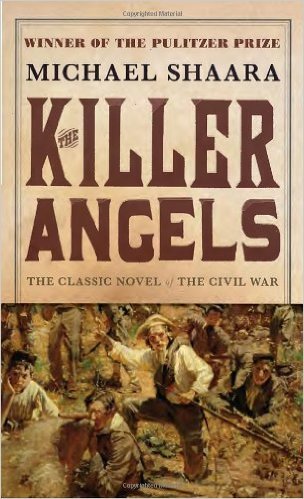
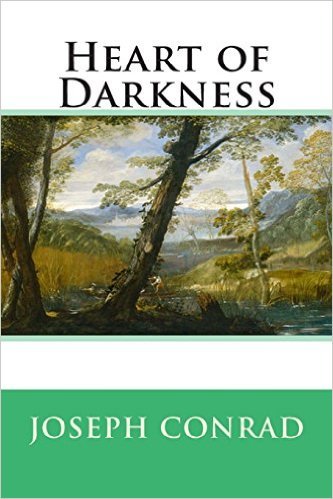
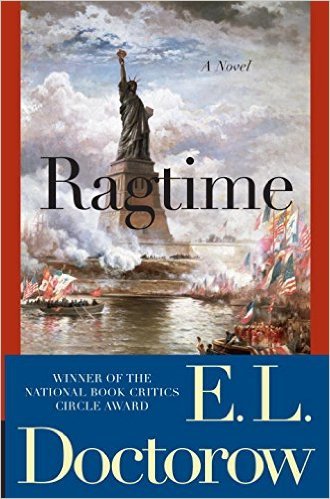
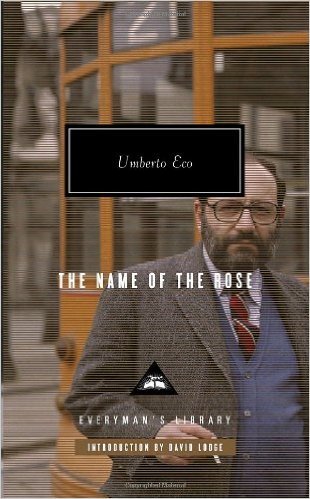
Two Categories
There is more than one type of historical novel. One type takes actual events and, through good writing, dramatizes them. This is what Michael Shaara has done in The Killer Angels, one of the novels in his trilogy in which he dramatizes battles of the Civil War.
Then there is the imaginative use of the past to create an entirely new story, an alternative history, with deep themes. Joseph Conrad does this in Heart of Darkness, which makes an important statement about imperialism. Or E. L. Doctorow’s Ragtime, which mixes historical figures and fictional characters to reveal issues surrounding racism, marriage, women’s rights, and more.

My novel, The Lies That Bind (Book 1 in my DarkHorse Trilogy), is this second category of fiction. Using some unusual twists and concepts, The Lies That Bind attempts to create a new experience for the reader, even though it is set in a familiar place and time, a rural hamlet in antebellum Mississippi. Using this method enabled me to offer the reader different perspectives on race, gender, family dysfunction, friendship and brotherhood, power lust, economic markets, and a host of other issues. Precisely because The Lies That Bind isn’t tied to actual events, I was free to add in surprising plot twists, as well as pathos, irony, humor, really anything that I felt fit the story.
There is much good reading out there to fulfill and enlighten historical novel readers of all kinds. For me, I’m re-reading Umberto Eco’s .
Sign up here to receive Ed's blog posts directly.
Historical Novel Society Review of The Lies That Bind: “The action and drama are compelling from the first page to the exciting conclusion. The animosity between the French plantation and Hurst builds to an exciting and surprising climax. Antoinette is so mysterious, one doesn’t know of her mission until the end. Highly recommended, and I am anxious to read the next installment.”
August 9, 2016
Playing with Story Structure to Delight the Reader
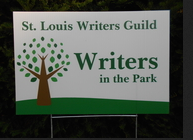
Last Saturday, I participated in the St. Louis Writers Guild’s annual Writers in the Park event, where area writers could attend workshops, network and sell their books to the public. One of the sessions I attended was David Lucas’ (president of the SLWG) presentation, which outlined several types of novel structure. Listening to him made me think about the ways in which I use these techniques to structure my novels.
Telling the Story
As I’ve mentioned before, I’m working on Honor Among Outcasts, the follow-up to The Lies That Bind (book 1 of my DarkHorse Trilogy). My novels are so imaginative, one could assume I develop them by “seat-of-the-pants” method. I confess, I do like to let the stories go where they will, to create interesting characters and to let their natures build the action, to let them surprise the reader and me. As a writer and a reader, I like the little surprises that show up in a story as much as anyone.
However, there is much more method to my madness than that.
The Structure
David covered the four-part structure, which I often rely on to give the story a spine, to make it easy for the reader to follow. For example, the first two sections might encompass these elements:
· The Set-up. To establish The Lies That Bind, I put all the major characters in a troubling situation in the first quarter of the book. For instance, Durksen Hurst, my “hero” (or anti-hero), and his partners, a group of slaves, devise a scheme to build their own plantation called DarkHorse. By the end of that section, they’ve acquired the land and are in a pretty precarious position, having to build a plantation and not get exposed, with death and danger lurking around every corner.
· The Development. The second section begins with Antoinette, whom Durk loves, ready to abandon him on her own secret mission. Antoinette, too, has her set up and development. You will find Cassandra-like, mysterious Antoinette a very complex woman, certainly not a typical “heroine.” Additionally, in this section, Durk and his partners clash with the wealthy and powerful Frenches (Devereau French and his mother, Missus Marie Brussard French), who are trying to do them in.
A word here: In defiance of typical structure, The Lies That Bind has a second hero (or “anti-hero”) in Durk’s antithesis, Devereau French. Devereau, who is struggling for his own freedom from his manipulative mother, is not your typical villain. Rather, Devereau has his own set of problems, which will delight and amaze. Readers will see how Durk’s and Devereau’s problems are different—and yet the same.
Sections three and four have their own characteristics, but that’s for another blog.
It may seem that I’m constantly defying structure; yet I am really just playing with standard structure. My goal is to produce constant surprises for the reader and, I confess, to amuse myself!
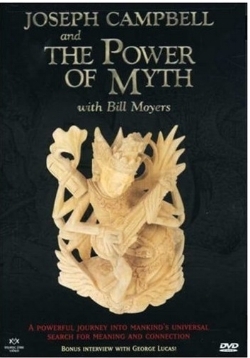
Mythology as Structure
In his presentation, David also tied storytelling to Joseph Campbell’s writings on myth. Campbell studied all the world’s myths and found common elements among them, elements that are found in the most successful fiction. Theoretically, every story we read is, in essence, a new myth. One can argue this stuff all works based on our basic human wiring. Right?
Campbell writes that all myths, symbolically, feature a hero on a journey. The hero leaves the ordinary world and is called to an adventure. In The Lies That Bind, Durk plunges into the swamp/forest; he and his partners scheme to build an egalitarian plantation in a slave society.
According to Campbell, at some point the hero is tested and discovers who his allies and his enemies are. Clearly, Durk’s partners are his allies: their lives all depend on trusting each other. And the Frenches are his enemies. Right? Not so fast!
Devereau (my other “hero”) is being driven by his mother to destroy Durk and his partners. However, Devereau resists—he doesn’t want to do it. Now Devereau, as a second hero, is defying the mythological structure. Is he a friend or enemy of Durk’s? Why won’t he accept the role of enemy?
Finally, there is resurrection in the hero’s story, where the hero’s final problem is solved. Here, too, I give it all a twist so that the reader is surprised and left nearly breathless. Does Durk solve his problems (many of which he created himself)? Does Devereau gain freedom from his mother? Does Devereau defeat Durk or vice versa? Or do they both experience something a bit more ambiguous?
Of course, there are more stages to a myth than the ones I’ve provided. To learn more, see Campbell’s ground-breaking work, The Power of Myth. (See Bill Moyers PRB series.)
As you can see, from beginning to end, The Lies That Bind toys with traditional structures. I hope I’ve played well on readers’ expectations and delighted them with the book’s many shockers.
News Flash! The Lies That Bind received two new flattering reviews this summer:
· Historical Novel Society: “The action and drama are compelling from the first page to the exciting conclusion. The animosity between the French plantation and Hurst builds to an exciting and surprising climax. Antoinette is so mysterious, one doesn’t know of her mission until the end. Highly recommended, and I am anxious to read the next installment.”
https://historicalnovelsociety.org/reviews/the-lies-that-bind-book-one-of-the-darkhorse-trilogy/
· Midwest Book Review: “The debut novel of author Ed Protzel's 'Dark Horse Trilogy' series, ‘The Lies That Bind’ is a deftly crafted and consistently compelling read from beginning to end. While strongly recommended for community library Historical Fiction collections, it should be noted for personal reading lists that ‘The Lies That Bind’ is also available in a Kindle edition ($4.99).”
http://www.midwestbookreview.com/sbw/jul_16.htm#Fiction
Not receiving Ed's blog posts directly? Join his email list.
Arrange a Visit
I love speaking to book clubs, organizations, bookstores or libraries about writing, history, or (of course) The Lies That Bind and my DarkHorse Trilogy.
To request a visit, just send me an email at: ed.protzel@att.net.

Speaking at Left Bank Books, St. Louis
August 1, 2016
Historical Novel Society Review
"The action and drama are compelling from the first page to the exciting conclusion. The animosity between the French plantation and Hurst builds to an exciting and surprising climax. Antoinette is so mysterious, one doesn’t know of her mission until the end. Highly recommended, and I am anxious to read the next installment."
Find the summary and review at: https://historicalnovelsociety.org/re...
Find a preview of THE LIES THAT BIND on Amazon & Goodreads.
Great story-lines for discussion, debate and interpretation!
June 27, 2016
Faulkner’s Absalom, Absalom! and Me
Back after a much-needed break and ready to blog — this time about my favorite author and novel, William Faulkner’s Absalom, Absalom!, and its influence on my own novel, The Lies That Bind.
I had the chance to talk about Faulkner at a videotaped interview prior to my most recent reading at Left Bank Books in St. Louis, where I was asked: What are you reading now?”
Knowing I would be asked the question allowed me to think about my answer in advance. The exercise gave me quite a few insights about myself — and about the nature of literature.
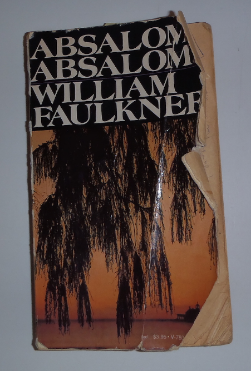
As I say in the interview, I am re-reading Absalom, Absalom! for the umpteenth time. Published in 1939, Absalom, Absalom! is considered one of—if not the—greatest novels of all time, voted the best Southern novel of the 20th century by Oxford American. My copy (above) is well-annotated and -worn (as you can see).
What is it that makes this book so great, you may ask? and how has it influenced my novel?
Absalom, Absalom! breaks many of the rules of novel-writing. Yet, these supposed “violations” of accepted literary norms are a real strength of Faulkner’s narrative, making the novel unique — and very powerful. Power, yes. Like any Faulkner work, but even more so in Absalom, Absalom!, you have to work a bit to get through it. But as I said in the interview, when you are done, you are satisfied, in a profound way, emotionally and intellectually.
See video, “Ed Protzel Talks Faulkner.”
Two Distinct Norms
Two unique ways that Faulkner defies norms in Absalom, Absalom! First, instead of an economy of words, he deluges the reader with the most diverse and incisive language I’ve ever read. Matchless. Second, and as importantly, Faulkner doesn’t present the story in linear fashion. Rather, each chapter tells the story repeatedly, often by different narrators, relating events over and over, and in each new telling he reveals new insights. In Absalom, Absalom!, Faulkner found a whole new way to tell a story, to write a novel. It takes getting used to, but it’s worth it.
Absalom, Absalom! was a major inspiration for The Lies That Bind — but sometimes I reversed his concepts. As far as language goes, no one can duplicate Faulkner, and shouldn’t even try. Rather, operating on my own literary theories and style, I try to be as economical as possible, using impressionistic descriptions to set the scene and the mood.
Take this example from The Lies That Bind:
Dusk rapidly closed in, the sun’s retracting tendrils leaving bloody claw-marks upon the clouded sky. The final residue of daylight drained quickly behind the western hills, drawing with it what little warmth remained of the day.
Like Faulkner’s tale, in Lies, as the plot moves forward chronologically, revelations about the characters’ pasts move back in time, revealing the novel’s themes. You can see the Faulkner influence there.
But there is one major difference at the heart of my novel that is entirely contrary to Faulkner’s tale: I give credit and identity to the slaves. He did not.
That always troubled me about Faulkner’s great work. The central character in Faulkner’s novel is Thomas Sutpen, who built a great plantation out of a swamp, called Sutpen’s Hundred, a man who is emblematic of the antebellum South and its slave society, its rise to power, and its fall. While the narrators boast of Sutpen’s success, they barely mention his slaves. Had they nothing to do with the creation of Sutpen’s Hundred?
Thus, one of my motivations for writing The Lies That Bind, my whole concept for the novel, was to correct that racial omission. In fact, in The Lies That Bind, the townsfolk (in antebellum Mississippi) give the protaganist, Durksen Hurst (a free, mixed-blood white-Seminole charlatan), credit for the success of his DarkHorse plantation. But the reader knows the truth: that it’s Durk’s secret partners, former slaves, who conteribute the agricultural expertise to their mutually owned plantation. In fact, one of the slaves, Big Josh, who had once run the plantation for his former dissolute master, was the real brains of the operation, something that actually happened historically.
No, no writer can match William Faulkner or compare his writing to the great man. Lies is a much faster, easier read than Absalom, Absalom!, and I use very different techniques to tell a very different story, with more modern themes. But seeing how I play off Faulkner’s novel is a lot of fun—and, I hope, enlightening, as well.
Upcoming Reading: Sept. 25, Garden District Book Shop, New Orleans
May 16, 2016
Creating Ellen: Her Fictional Function

Last week, I talked about Ellen, a seemingly minor character in my historical novel, The Lies That Bind, and how readers have responded to her. Minor? You be the judge.
In the novel’s initial outline, I referred to Ellen merely as “granddaughter,” who is present when Durksen Hurst registers a deed for land with her grandfather at his store where the hamlet’s records are kept. (The land is where Durk and his partners - former slaves - planned to build their egalitarian plantation.)
Yet somehow, as I began developing that scene, my fingers seemed to take over, and the “store” became a hapless business establishment named the Honor Store; the “grandfather” became the fanatical fundamentalist Senior Deacon; and the “granddaughter” grew into mousy, unworldly, seventeen-year-old Ellen. I had fun writing it, and I think that’s why readers have fun reading it!
Although Ellen only appears a few times, she adds a fresh and wholly unexpected tone to the otherwise jaundiced tale. Is it innocence? idealism? faith? Her appearances offer belly-laugh humor that breaks from the rest of the story’s heartrending dramatic tension and, thus, serves an important emotional component to the book’s overall theatrics. Just as importantly, Ellen’s actions near the end of the book give the reader a great deal to think about. Indeed, such a perspective calls into question all of the book’s themes, the other characters’ motivations, and the very foundational assumptions of the antebellum South. That’s a lot for an ancillary character!
She Cannot Tell a Lie
In the novel, all the main characters develop complex schemes in order to survive. Each lives a lie—and often tells lies. Ellen, on the other hand, cannot lie. Her first brief appearance so intrigued me that I decided she, not her grandfather, would have the job, the privilege, of providing manumission papers to Durk in his attempt to free his partners. After this single act, Ellen comes to believe she is being guided by God to free all of the town’s slaves. Suddenly, Ellen has her own personal crusade—and a place in the story as a true heroine!
Ellen’s Creative Source
What literary tradition inspired my creation of Ellen and the impractical Honor Store? If you’ve read Shakespeare, you’ve probably noted that his dramatic works often have humorous, parallel characters and subplots.
Like Shakespeare’s clownish minor characters, Ellen and her grandfather have motivations far different from everyone else in the story. The Honor Store is not founded on profit, but on other (religious) ideals: charity, neighborliness, etc. For that reason, we know the Honor Store could not survive in the real world, which is what makes it funny to modern-day thinking.
Likewise, Ellen’s motivation is barely tangential—if at all—to practicality. Therefore, in The Lies That Bind’s world of schemers and plotters, Ellen’s purity of thought stands out. And that bright point of view contrasts with the rest of the novel’s dark perspective. The question then becomes, who is right? The archaic Ellen, who lives deeply in ancient beliefs, or the other characters who live in fear and uncertainty? Maybe that idealism, that purity elevates Ellen beyond minor character status. You, the reader, will have to decide that for yourself.

Upcoming Reading: Thurs., June 23, Left Bank Books, St. Louis Central West End, where I’ll be reading some scenes involving Ellen, among others.
Taking a break - back in June!



